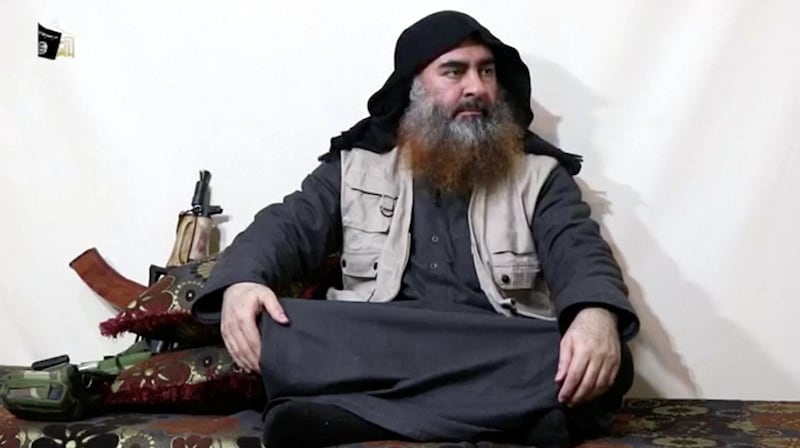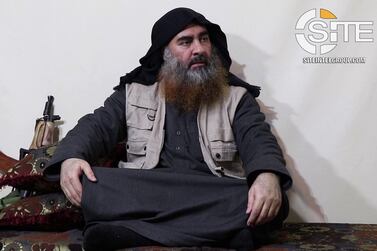The first video message in five years from ISIS leader Abu Bakr Al Baghdadi emerged on Monday, in which he sought to reassure his followers after the group's defeat in Iraq and Syria.
The 18-minute video released by the terrorist organisation’s media arm Al Furqan shows Al Baghdadi next to an assault rifle, seated in a white-walled room while speaking to three followers.
The ISIS leader looks physically well despite signs of ageing. His beard is longer and more grey, dyed with henna at the end, and his hands are paler.
"The battle for Baghouz is over," Al Baghdadi said as he spoke about future attacks and areas of presence for ISIS, and recent assaults across Africa and in Sri Lanka.
A US State Department official said that Washington was “aware of the video” and that government analysts and intelligence agencies would review it to confirm its authenticity.
The US official called the territorial defeat of ISIS in Iraq and Syria “a crushing strategic and psychological blow for its so-called caliphate”.
But he said that the fight against ISIS was not finished and any remaining leaders in the group would be “delivered the justice they deserve”.
Counter-terrorism experts say the video is meant to boost ISIS's supporters after the recent losses, and is an attempt by Al Baghdadi to exert his control.
Amarnath Amarasingam, a senior research fellow at the Institute for Strategic Dialogue, told The National that the video is aimed at putting the defeat in Baghouz in Al Baghdadi's own context.
“This is the context in which he thanks key leaders, key media figures and focuses on recent attacks,” Mr Amarasingam said.
“He wants to show that it was largely inevitable that the caliphate would have been defeated and that the West was never going to allow such a state to exist.
“Whatever is the next stage of ISIS, Baghdadi wants to assure his followers that he’s still in charge and not incapacitated."
Mia Bloom, professor of communications and author of the book Small Arms: Children and Terror, said the video was about Al Baghdadi's own leadership and control of ISIS.
Dr Bloom told The National that he wanted to show he was physically well after rumours that he was wounded last year, and that "he is aware of all the ISIS operations to give the impression that he's in control".
In the footage, Al Baghdadi mentions terrorist attacks in Sri Lanka and Nigeria that ISIS claimed.
“He wants the West to overreact to this video so that the ISIS rhetoric and ideology resonates with its support base,” Dr Bloom said.
She said that the video's editing techniques could imply that Al Baghdadi did not direct the production.
“He seems very up to date,” Dr Bloom said.
She was referring to his mentions of recent events such as Israeli Prime Minister Benjamin Netanyahu’s re-election and the removal of Algerian and Sudanese presidents Abdelaziz Bouteflika and Omar Al Bashir.
Other experts such as Rita Katz, director of the Site intelligence group, saw the video as alarming to the West.
“There is serious danger not only to the fact that Baghdadi, ISIS’s so-called Caliph, is still alive but also that he is able to re-emerge to his supporters and reaffirm the group’s message of us versus the world after all the progress made against the group,” Ms Katz tweeted.








